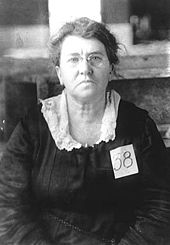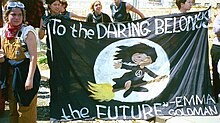Emma Goldman
Progressive Era Repression and persecution Anti-war and civil rights movements Contemporary Emma Goldman (June 27, 1869 – May 14, 1940) was a Lithuanian-born anarchist revolutionary, political activist, and writer.
[1] She and anarchist writer Alexander Berkman, her lover and lifelong friend, planned to assassinate industrialist and financier Henry Clay Frick as an act of propaganda of the deed.
Initially supportive of that country's October Revolution that brought the Bolsheviks to power, Goldman changed her opinion in the wake of the Kronstadt rebellion; she denounced the Soviet Union for its violent repression of independent voices.
[2] Her writing and lectures spanned a wide variety of issues, including prisons, atheism, freedom of speech, militarism, capitalism, marriage, free love, and homosexuality.
A passionate student, Goldman passed the exam for admission into a gymnasium, but her religion teacher refused to provide a certificate of good behavior and she was unable to attend.
(1863), she found a role model in the protagonist Vera, who adopts a Nihilist philosophy and escapes her repressive family to live freely and organize a sewing cooperative.
[26] At her new job, Goldman met a fellow worker named Jacob Kershner, who shared her love for books, dancing, and traveling, as well as her frustration with the monotony of factory work.
They came with passionate intensity...The audience had vanished, the hall itself had disappeared; I was conscious only of my own words, of my ecstatic song.Excited by the experience, Goldman refined her public persona during subsequent engagements.
[41] When a majority of the nation's newspapers expressed support of the strikers, Goldman and Berkman resolved to assassinate Frick, an action they expected would inspire the workers to revolt against the capitalist system.
"[45] Once on the street, Goldman caught the eye of a man who took her into a saloon, bought her a beer, gave her ten dollars, informed her she did not have "the knack," and told her to quit the business.
[61] She also read dozens of books, including works by the American activist-writers Ralph Waldo Emerson and Henry David Thoreau; novelist Nathaniel Hawthorne; poet Walt Whitman, and philosopher John Stuart Mill.
[66] On September 6, 1901, Leon Czolgosz, an unemployed factory worker and anarchist,[67] shot US President William McKinley twice during a public speaking event in Buffalo, New York.
[99] When Margaret Sanger, an advocate of access to contraception, coined the term "birth control" and disseminated information about various methods in the June 1914 issue of her magazine The Woman Rebel, she received aggressive support from Goldman.
[100] Sanger, too, was arrested under the Comstock Law, which prohibited the dissemination of "obscene, lewd, or lascivious articles", which authorities defined as including information relating to birth control.
When police began raiding the group's public events to find young men who had not registered for the draft, Goldman and others focused their efforts on distributing pamphlets and other writings.
[116] Goldman and Berkman were released from prison during the United States' Red Scare of 1919–20, when public anxiety about wartime pro-German activities had expanded into a pervasive fear of Bolshevism and the prospect of an imminent radical revolution.
"Emma Goldman and Alexander Berkman," Hoover wrote while they were in prison, "are, beyond doubt, two of the most dangerous anarchists in this country and return to the community will result in undue harm.
"[118] Louis Post at the Department of Labor, which had ultimate authority over deportation decisions, determined that the revocation of her husband Kershner's American citizenship in 1908 after his conviction had revoked hers as well.
[120] The Labor Department included Goldman and Berkman among 249 aliens it deported en masse, mostly people with only vague associations with radical groups, who had been swept up in government raids in November.
[138] In 1925, the spectre of deportation loomed again, but James Colton, a Scottish anarchist Goldman had first met in Glasgow whilst on a speaking tour in 1895,[139] had offered to marry her and provide British citizenship.
"[145][146] In 1928, she began writing her autobiography, with the support of a group of American admirers, including journalist H. L. Mencken, poet Edna St. Vincent Millay, novelist Theodore Dreiser and art collector Peggy Guggenheim, who raised $4,000 for her.
[156] Goldman began to worry about the future of Spain's anarchism when the CNT-FAI joined a coalition government in 1937—against the core anarchist principle of abstaining from state structures—and, more distressingly, made repeated concessions to Communist forces in the name of uniting against fascism.
She was influenced by many diverse thinkers and writers, including Mikhail Bakunin, Henry David Thoreau, Peter Kropotkin, Ralph Waldo Emerson, Nikolai Chernyshevsky, and Mary Wollstonecraft.
"[174] While she never gave explicit approval of Leon Czolgosz's assassination of US President William McKinley, she defended his ideals and believed actions like his were a natural consequence of repressive institutions.
With nothing but hunger and inhumanity to greet them, these victims soon sink back into crime as the only possibility of existence.Goldman was a committed war resister and was particularly opposed to the draft, viewing it as one of the worst of the state's forms of coercion, and was one of the founders of the No-Conscription League for which she was ultimately arrested and imprisoned in 1917 before being deported in 1919.
[186] Goldman was routinely surveilled, arrested, and imprisoned for her speech and organizing activities in support of workers and various strikes, access to birth control, and in opposition to World War I.
[192][193] Although she was hostile to the suffragist goals of first-wave feminism, Goldman advocated passionately for the rights of women, and is today heralded as a founder of anarcha-feminism, which challenges patriarchy as a hierarchy to be resisted alongside state power and class divisions.
As Goldman wrote in a letter to Hirschfeld, "It is a tragedy, I feel, that people of a different sexual type are caught in a world which shows so little understanding for homosexuals and is so crassly indifferent to the various gradations and variations of gender and their great significance in life.
Her essay "The Philosophy of Atheism" quoted Bakunin at length on the subject and added:[200] Consciously or unconsciously, most theists see in gods and devils, heaven and hell, reward and punishment, a whip to lash the people into obedience, meekness and contentment....
She blamed Christianity for "the perpetuation of a slave society", arguing that it dictated individuals' actions on Earth and offered poor people a false promise of a plentiful future in heaven.















